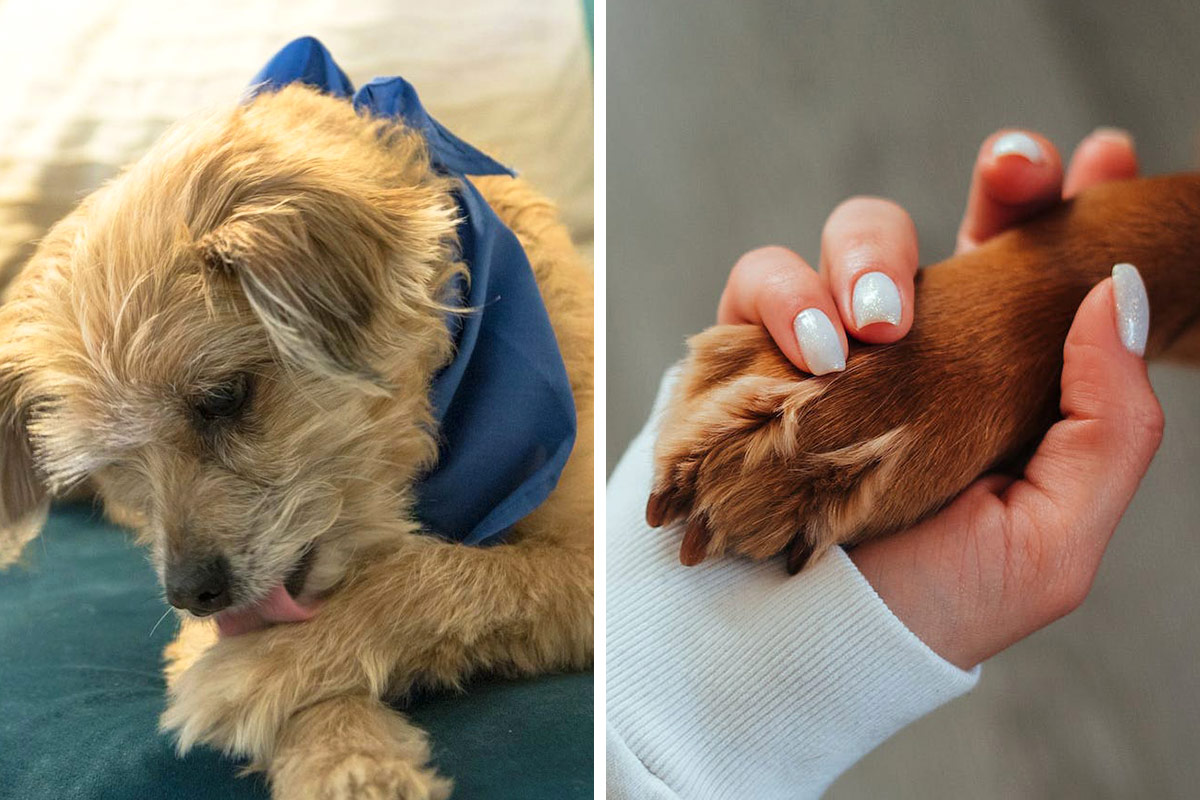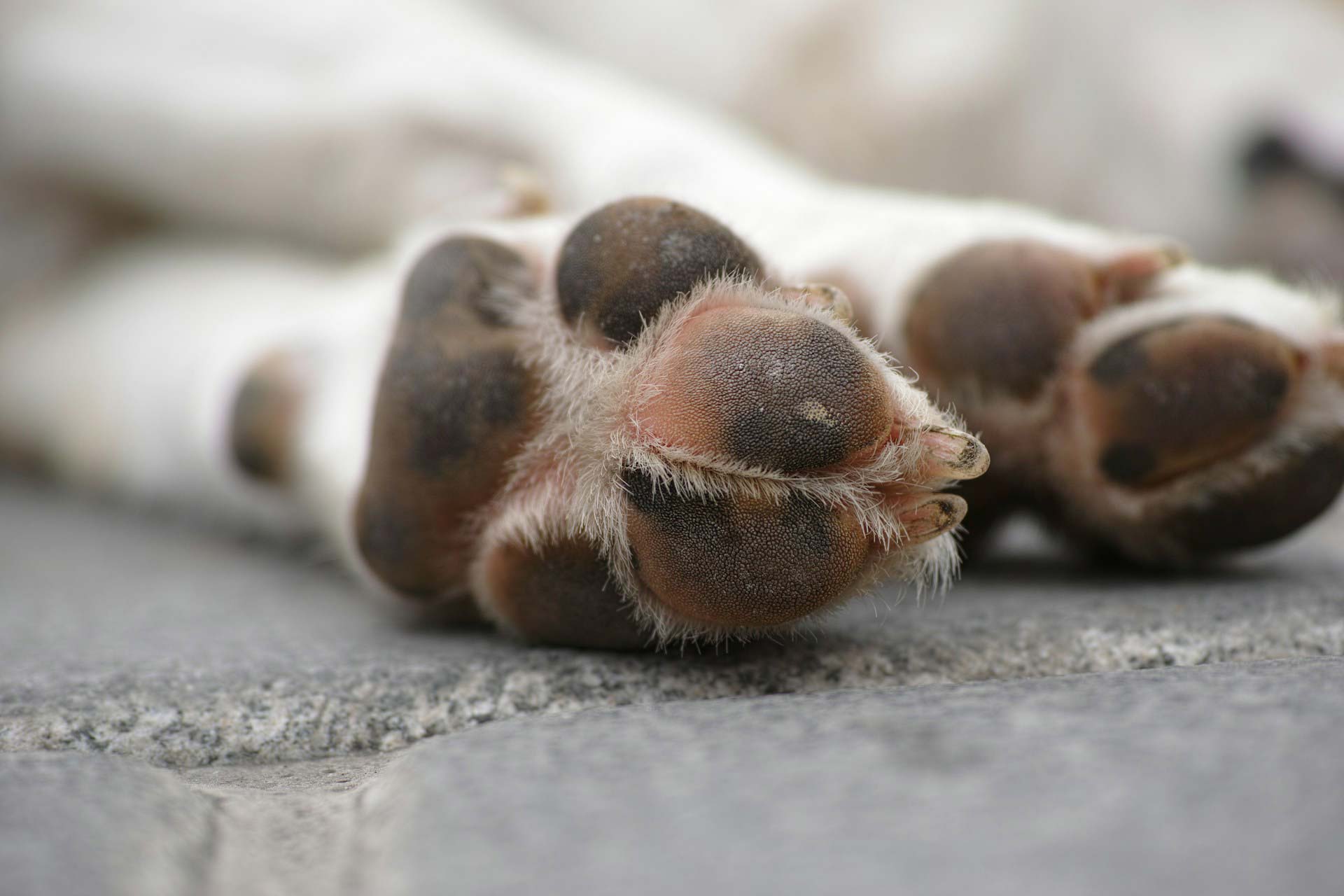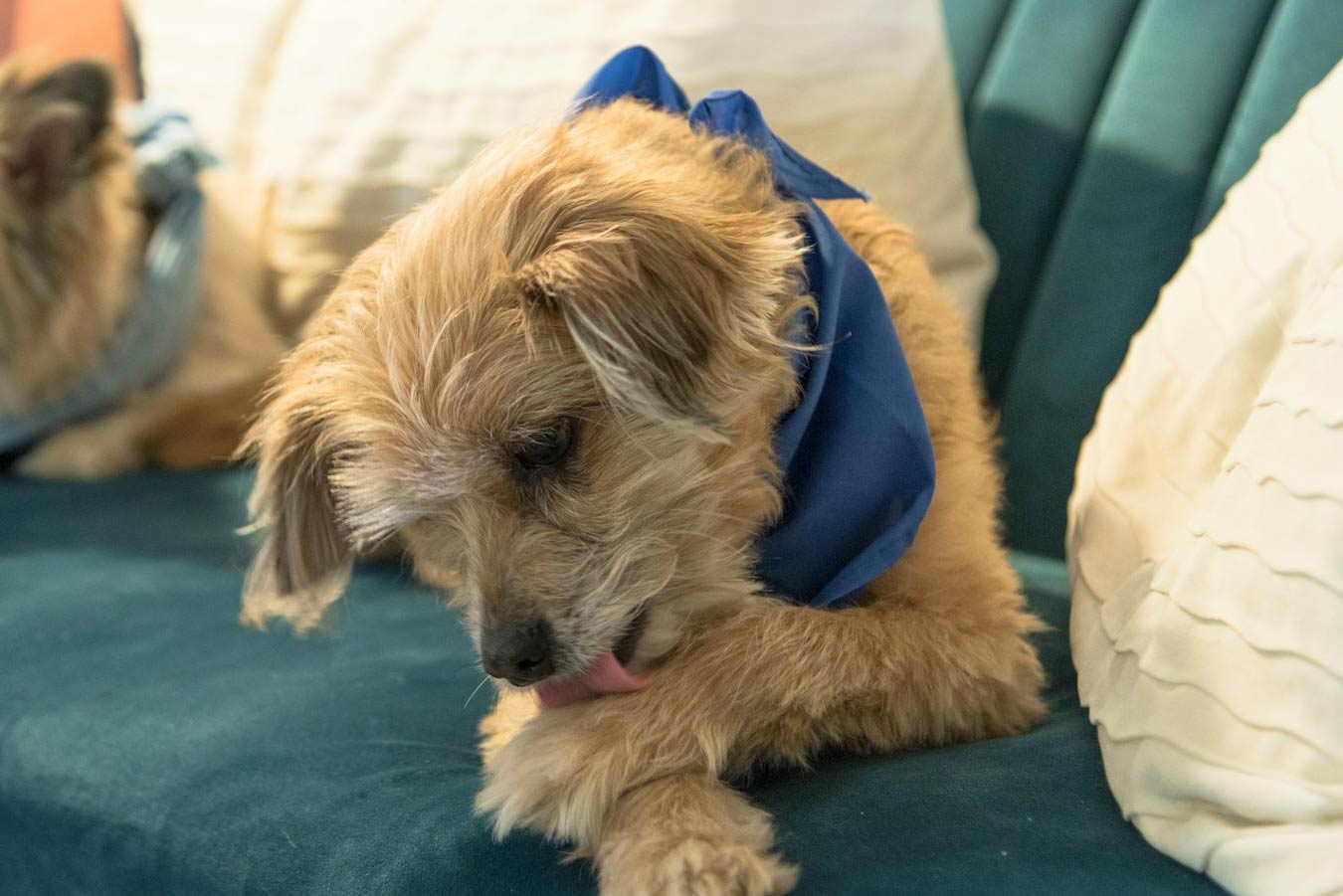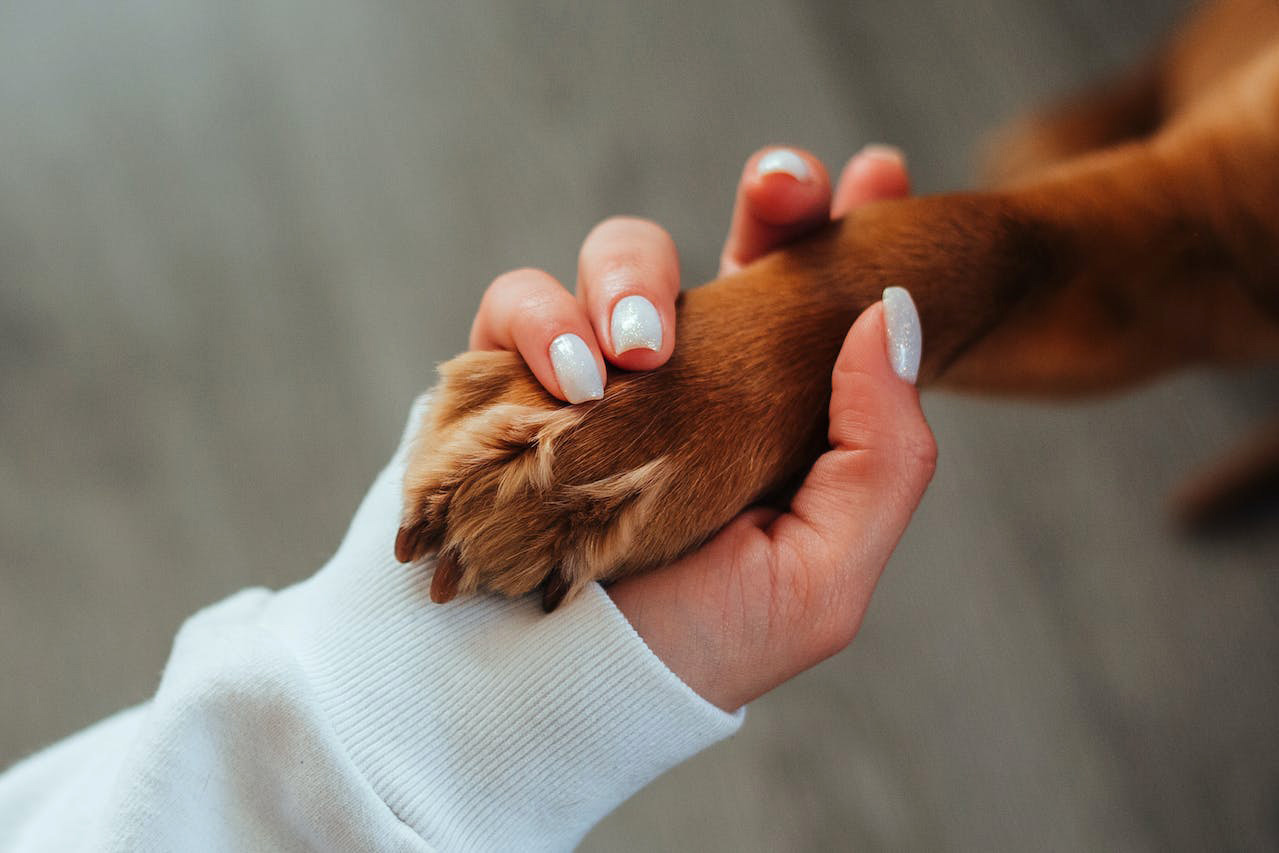
Why Is My Dog Licking Their Paws: Causes and Solutions for Itchy Paws
Some dogs will lick their paws from time to time, but maybe your dog is licking it paws excessively. What would cause your dog to do this, and when should you take your dog to see a vet? Keep reading to find out everything about licking paws and what to do!
The information provided herein is for informational purposes only. Please refer to our disclaimer for more details..
Understanding Why A Dog Lick Their Paws
Understanding paw-licking behaviour in dogs is crucial for responsible pet ownership. While occasional licking is perfectly normal, especially after a nice walk outside, excessive or constant paw licking may signal an underlying issue.
Observing the frequency, intensity, and context of paw licking helps discern whether it’s a behavioural habit or may be a symptom of discomfort.
Pay attention to your dog’s overall health, environment, and behaviour, and you can better comprehend the reasons behind paw licking and take appropriate measures to address any potential concerns, ensuring your furry friend enjoys optimal well-being.
Common Reasons For Paw Licking
Dogs may lick their paws for various reasons, and understanding these behaviours is essential for dog owners to be able to know when to worry and when just to let it go.
One of the most common reasons dogs lick their paws is infections within the skin between the paw pads. These skin infections are typically caused by a bacterial infection or a type of yeast infection. These infections are really itching, causing a dog to lick their paws to scratch that itch.
Some dogs may also lick their paws as a self-soothing mechanism to respond to anxiety or stress, like separation anxiety, or as a response to pain.
Over time, this type of behaviour can also turn into bad habit, even if the underlying cause has been addressed. Licking can cause itching, which causes more licking, making it a bad circle. However, at times, it can also be a simple matter of dirty paws and a natural grooming pattern.
Examining the context is crucial; occasional cleaning is routine, but persistent licking may indicate an underlying problem.
To help you out, we will cover the most common causes of paw-licking, so stay tuned!
Bacterial or Yeast Infection and Food Allergies
One of the most common reasons for a dog to excessively lick its paws is an infection of the skin of the paw or toes, also called Canine Pododermatitis
These infections can almost always be attributed to either bacterial- or yeast skin infections, with the most common culprits being Staphylococcus bacteria or Malassezia.
Staphylococcus bacteria can thrive on the skin’s surface, causing irritation and infection when they grow. Malassezia, a yeast, can also proliferate in the warm and moist regions between a dog’s toes.
Skin infections in the paws can manifest as primary issues, often due to either a small cut or similar wear and tear of the paws. Or, as it most often is, it can be a secondary response to an underlying condition, such as allergies. Allergies often, or almost always, plays a role when it comes to itchy skin.
Allergies are very prevalent in dogs today. It can occur for various reasons, but all dogs are typically allergic to items within their food, often meat or dairy. Or the dogs may be allergic to something in their environment, like dust mites or pollen, so called environmental allergies. These conditions may affect one paw or both.
Whatever causes the allergic reaction, it will often cause the dogs paw to become itchy and may then allow bacteria and yeast infections to flourish – especially as a wet dog tongue provides the perfect environment.
Some breeds are more predisposed to developing allergies; these especially include poodle mixes like the Havapoo, the Labradoodle, and the Maltipoo, or breeds with skin folds.
You can help prevent bacteria and yeast infections of the skin by maintaining paw hygiene. This will include regular cleaning of the paws to avoid any irritants and ensure that the paws remain dry after a walk in the wet environment outside.
If you suspect your dog has a paw infection, you should seek veterinary care. These infections are often very uncomfortable for the dog and may worsen significantly in a short period of time.
Treatment will often include washing the paws in a chlorhexidine solution to combat the bacteria or yeast overgrowth, as well as a topical or oral medication to help curb the symptoms of itching.
If you struggle with giving your dog tablets, we recommend that you mention this to your vet beforehand, or you can take a look at our article here to help you: How To Give Your Dog a Pill.
Understanding the intricacies of these paw infections is vital for dog owners to provide proactive care and address their pet’s overall well-being.
Paw Licking and Anxiety
Some dogs may compulsively lick their paws as a response to stress and anxiety, as a way to self-soothe.
Various situations often trigger the behaviour and are often very difficult to pinpoint. Some dogs may experience anxiety or stress as a response to changes in the environment, new people or animals, or loud noises.
Some dogs may also experience severe anxiety related to being left home alone.
Anxiety or stress is not limited to a few breeds. All dogs can develop anxiety and self-soothing patterns, although some breeds are more prone to developing behavioural issues as a response; these include Chihuahuas and Bichon Frises,
Dealing with anxiety and stress at home often includes maintaining a consistent routine, providing a safe space for the dog, and incorporating mental activities, as well as training techniques involving positive reinforcement and desensitization to anxiety triggers.
If your dog is always hyper, it may also be a sign a stress. Here are some ways you can help your dog calm down at home.
However, sometimes what you can do at home is not enough. Persistent licking may require professional help. A dog behaviourist can help identify underlying issues and recommend appropriate interventions, such as behaviour modification or medications, to alleviate anxiety in the long term.
Excessive Paw Licking and Pains
Dogs may also lick their paws as a response to pain. Have you ever been unable to keep from pressing a bruise somewhere? Dogs aren’t that unlike us.
A dog may lick at a painful spot on the paw to try and alleviate the discomfort or simply because they are bothered by the area. Identifying the source of their discomfort is crucial for their well-being and may require veterinary help to identify it correctly.
An almost endless amount of things can cause pain in a dog’s paw. Often it is due to traumatic injuries, like cuts, scrapes, or foreign objects.
However, conditions like arthritis or joint problems can also manifest as paw pain and, in turn, paw licking.
What is even worse is that the excessive licking can then lead to a skin infection, which can then cause more pain. Talk about an annoying situation.
If a dog consistently licks a specific area, it may indicate an underlying painful problem. Pay attention to limping, changes in behaviour, or visible signs of injury.
While minor issues might be managed at home with cleaning and monitoring, persistent pain or signs of distress warrant a vet visit. Timely veterinary care ensures accurate diagnosis and appropriate treatment, preventing potential complications.
The Dog Is Constantly Licking Their Paws – When Is it Too Much?
Paw licking is an everyday grooming behaviour and a way for dogs to explore their environment. Occasional paw licking is usually harmless and not something to worry about.
Determining precisely when it becomes excessive may be challenging, but this is where the dog owner knows best. The owners know their best friends and are the very best at identifying when a behaviour has changed.
Nonetheless, excessive or obsessive licking should be a cause for concern for all owners.
How To Prevent Paw Licking at Home
There are a few things you can do at home to help prevent issues with paw licking and the conditions that accompany it.
Regularly inspect your dog’s paws for signs of irritation, redness, or swelling. You can also smell your dog’s paws unless they have just been outside; they should not smell uncomfortably bad. If you notice any abnormalities, it’s essential to investigate further.
Preventing skin infections involves maintaining good paw hygiene. Clean your dog’s paws regularly, especially after walks or outdoor activities, to remove potential irritants and allergens. Make sure to dry them thoroughly afterwards, and, of course, attempt to avoid known allergens.
Additionally, be cautious about the surfaces your dog walks on, as irritants like certain chemicals or allergens can be present.
Stress and anxiety can contribute to paw licking, so providing a stimulating and enriching environment at home is crucial. Regular exercise, mental stimulation through activities like training, toys and puzzles, and a consistent routine can help alleviate stress and anxiety.
Identify potential stressors, such as changes in the home environment or loud noises, and address them appropriately.
Some at-home pain management is possible if your dog is experiencing pain. However, it should only be done under the guidance of a trained veterinarian, and you should never attempt to give your dog pain medication at home without consulting a veterinarian first.
When to Consult a Veterinarian About Paw Liking in Dogs
Knowing when to seek veterinary assistance or the help of a dog behaviourist is crucial when dealing with excessive paw licking in dogs. Although some cases may have straightforward solutions, persistent or severe licking warrants professional evaluation.
Veterinary attention is especially necessary if your dog’s paw licking is accompanied by visible signs of irritation, such as redness, swelling, or sores.
Behavioural causes, such as stress or anxiety, may also necessitate professional assistance. If you’ve attempted at-home strategies to address stressors or have identified potential triggers without improvement, consulting a dog behaviourist can provide insights into your dog’s behaviour and help implement effective behavioural training.
Other changes that may warrant calling the vet are changes in the dog’s overall demeanour, appetite, or energy levels, and they should not be ignored.
Discussing any changes in your dog’s behaviour during routine visits or health checks allows your veterinarian to monitor your dog’s overall health and well-being and provide early relief when needed.
In summary, seek veterinary assistance if your dog’s paw licking has become excessive or is accompanied by physical signs of discomfort, and consult a dog behaviourist for persistent or severe behavioural issues.
Conclusion: Happy Paws, Happy Dog
In conclusion, understanding and addressing excessive paw licking in dogs is a part of responsible pet ownership.
While occasional licking is ordinary, persistent or obsessive behaviour can indicate underlying issues. Whether caused by infections, stress, pain, or simple grooming habits, attentive owners can play a crucial role in their dog’s well-being by keeping an eye on the situation.
Seek veterinary assistance if redness, swelling, or sores accompany the licking, ensuring prompt diagnosis and treatment, or if you are worried about your dog.
Keeping on top of any issues that may arise will help keep your four-legged friend happy, healthy, and walking on all four paws.
243views
Share on Facebook Image credits:
Image credits:  Image credits:
Image credits:  Image credits:
Image credits: 


3
0